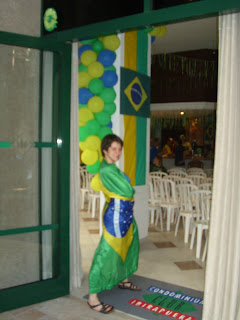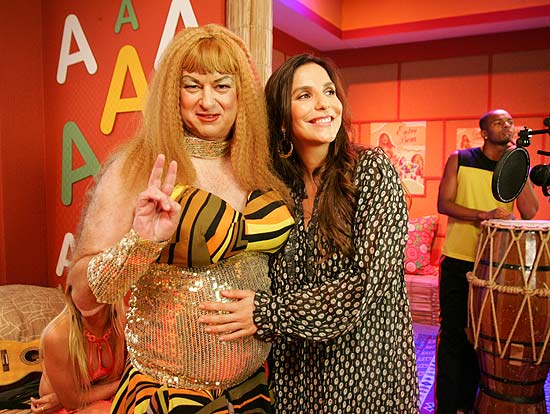I've been in Brazil for just over a month and a half now. I've been having a great time. Work is great, the food is better, it's great to see my extended family and meet new people. My portuguese has improved a lot; for the first time in 18+ years, my default language is Portuguese, not English or French. I've figured out the transit systems in São Paulo, and learned how cross streets with only minimal fear for my life. I sometimes feel a little lonely, but everyone has been so welcoming that my loneliness is always short-lived. I watched the first World Cup game at a coworkers house, with his parents, sisters, fiancée, son-in-law, dog and tiny kittycat. The parties here are amazing, and my love for outlandish costumes and enthusiastic dancing is encouraged ! Even in the dead of the Brazilian winter, we have occasional 25 degree days, and the tropical foliage is absolutely beautiful.
Quite frequently, I get asked by family or coworkers whether I'd consider moving here permanently. Unfortunately for my dreams of eating fresh tropical fruit for breakfast every morning, the answer is always no. The longer I stay here, the more I notice aspects of the culture that bug me. I'm a little hesitant to post this here, since anyone can read this blog, but I need to get this off my chest. Brazilian society is extremely racist, sexist, classist and homophobic. In fact, the longer I stay here the more I realize that brazilians have no real respect for
people in general, only status. The whole toxic mix is liberally sprinkled with a healthy dose of catholic guilt.
The first thing I noticed when I got here was the sexism, and it's what's been bugging me the most, probably because it's the aspect which affects me the most. It started out innocently enough; men rushing around to open car doors for me, or standing at elevator doors with their arms stuck out to let me through. At first I was bewildered. It all looked so silly. I actually had a coworker nearly crush my foot rushing to open a car door for me before I got to it. Then I found it amusing. Next, I started paying attention to the comments from people. I've received criticism on everything from my short hair to my unpierced ears and lack of makeup to my "boyish" tshirts. Worse, I've had several people suggest that I should change my appearance so that my boyfriend will like me more. Now, one thing I know for certain is that if I dyed my hair blonde (brazilians are convinced I'd look great as a blonde), wore heavy makeup, cleavagy tops, spike heels, dangly earrings, and got my nails transformed into bright pink talons, Jordan would be anything but impressed. In fact, I figure he'd probably shake me up and demand to know where I hid his laid-back, tomboyish girlfriend, and demand that I return her immediately.
But if it were all limited to telling me how to alter my wardrobe and grooming habits, I wouldn't be bothered. People tell me how I should be less of a tomboy all the time, even in Canada (albeit to a much lesser degree). However, the huge wealth disparity and objectifying culture has other side effects. You might all have heard about Brazil being the plastic surgery capital of the world. That's not a joke. Dinner parties regularly feature all the women sitting around a table poking at themselves and stretching their skin to demonstrate where their next surgery is going to be. Boob jobs, nose jobs, eye lifts, ear tucks, lipo, collagen injections, face lifts. You'd be hard pressed to find anyone in most gatherings who *hasn't* gotten any operations. Worse, this spills into younger age groups. I have cousins as young as 11 who have gotten plastic surgery. The adults don't see anything wrong with this, in fact, they think she should have gotten operated earlier.
But for all this encouragement to modify their bodies, women in Brazil are given no real control over their bodies. Abortion is illegal here. Thousands die in back-alley abortions. Nonetheless, the average age of first birth is 21(contrast to about 27 in Canada). Single-motherhood and divorce are also seen as shameful, leaving many women in very unpleasant situations. Most Brazilians recognize that this is a problem, but the catholic guilt is so ingrained that 85% of the population still believes that abortion should remain illegal. 65% believe that it should remain a criminal offence, punishable by jail time for both the abortionist and the mother.
The classism also really gets to me. Living in upperclass Brazil feels to me like living in a gilded cage. My family's apartments and houses are all beautiful, as are my coworkers. Hammocs are strung between palm trees, and there's always fresh tropical juices to sip, and beautiful pools and gardens. Gardens are perfectly maintained, houses are always spotless, and delicious food appears like magic out of the kitchen, all made possible by cheap labour. However, venturing out of this comfortable bubble is strongly discouraged. The reason claimed is because of the danger of getting robbed or catching a stray bullet, but that risk is often overstated because rich brazilians don't like associating with the lower classes. The first time I rode the interregional train, my supervisor at work nearly went catatonic, but couldn't express what the risk actually was. I checked with my aunt, and she explained that it's mostly just prejudice, as the trains and stations are well-lit, guarded and full of people, but that because a lot of poor people ride the train it's not seen as a pleasant ride. Reassured, I've started riding public transit more comfortably and venturing out into São Paulo on my own during the daytime. Nonetheless, most of my time is spent carefully sheltered behind guards, 10 foot walls and locked doors. I miss skipping through Toronto streets at any hour of the day or night. I miss not having to think about which are the dangerous areas, and at what time it stops being safe to ride the subway.
Then, there's the racism and homophobia. A common greeting to a black person (or even a darker-skinned white or latino person) is "Oi, nego/nega", which translates to "Hey, nigger". If you ask a Brazilian, they'll tell you it doesn't imply any hatred of black people, but the fact remains that there's no equivalent for white people. It's also quite common to refer to asian people as
japinhas (Japs) and black people as
pretinhos (blackies). Again, race never gets mentioned for white people, despite white people being the minority in this country. I can't really comment on how black people get treated apart from the othering comments, since I haven't experienced it, but I can't imagine that with so much casual racism, that there isn't a lot of more sinister comments, too.
Similarly, homophobia is ridiculously rampant. Canadians make gay jokes, but it doesn't even approach the level of the gay jokes, and offhand gay comments here. And then there's the quite frankly bizarre questions I get? I've had several people very bluntly ask me, out of the blue "So, are there a lot of gay people in Canada, too?". I'm always sort of stunned, and stammer something about "Erm, yeah, there's gay people everywhere in the world. Err, why?", which always gets answered with "It's not the same everywhere, there's gotta be more in Brazil. We've got too many of *them* here", usually followed with a joke about the gayest state being Rio Grande do Sul (damned if I know why that one specifically is the gayest state, but everyone seems to be in agreement about it). Most people leave it at that, but I've also heard a few too many people go on about how gay people are gross and make them want to puke.
It's disturbing to me how accepted this all is here. I miss the openness of Canadian culture.










